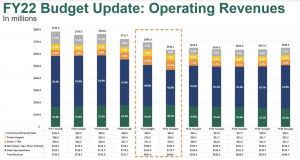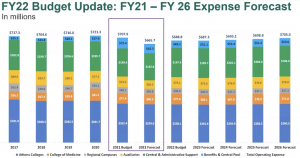News
Pandemic Deepens Ohio University’s Budget Crisis
By: David Forster
Posted on:
ATHENS, Ohio (WOUB) — Ohio University expects to lose about $20 million in revenue because so many students are choosing not to return to campus this semester.
This is just one piece of a projected budget deficit of $32.2 million for the current fiscal year, forcing the university to again dip into its reserves to plug the gap.
And the university’s budget picture remains grim moving forward.
In October, university leaders told the board of trustees they were projecting more than $290 million in deficits over the next five fiscal years, including the current year.
On Friday, the board was presented with deficit projections over the next six years, including the current one, that total $361 million. This is more than the university has available in reserves for covering budget shortfalls.
These projections are based on the university’s current situation in terms of how it makes and spends money. University leaders say they are working on ways to boost revenue and trim expenses and bring the budget back into alignment.
“We’re not standing still. We have in motion a number of key planning processes,” Ohio University President Duane Nellis said.

In the short term, the university’s budget is taking a beating from the coronavirus pandemic. The university lost millions of dollars in room and board revenue when the pandemic forced a campus shutdown in March and limited the numbers of students who could return to the dorms for the fall semester.
The university welcomed back all students who wanted to return to the dorms for the spring, and had forecast that 5,725 students would do so. Instead, about 3,200 students are returning to campus, about 44 percent less than expected.
The university projects that for fiscal year 2021, which began last July and ends this June, the pandemic will have cost $32.1 million in additional expenses and $78.7 million in lost revenue. About $53 million of this will be offset through state and federal relief funds. But that still leaves a loss of $57.8 million.
Budget projections for the next fiscal year assume a return to normal. But even with the pandemic out of the way, the university will still be dealing with a steep enrollment decline that began several years ago and isn’t expected to turn around for a few more years.
Most of the university’s revenue comes from tuition and room and board charges, so changes in enrollment have a significant impact on the bottom line.
Undergraduate enrollment on the Athens campus for the next fiscal year is projected around 13,700. That’s a drop of about 5,000 students, or 26 percent, from the enrollment peak five years ago.

Athens undergraduate enrollment is projected to drop even more the following fiscal year and then again the year after before it starts to tick back up again. Similar declines are projected for the university’s regional campuses.
These enrollment declines translate into three more years of projected revenue declines.
Meanwhile, expenses are projected to continue trending upward over the next several years. The growing gap between revenue and expenses will force the university to dip into its reserves year after year to balance the budget.
The projections show a $48.7 million draw in fiscal year 2022; $61.2 million in fiscal year 2023; $72.6 million in fiscal year 2024; $76.1 million in fiscal year 2025; and $70.2 million in fiscal year 2026.
Under these projections, by fiscal year 2026 there would likely not be enough left in reserves to plug the gap.
The best solution for turning around the university’s fiscal situation is to increase enrollment, and university leaders said they plan to offer significantly more financial aid as an incentive to recruit students.

Financial aid offered by universities comes in the form of discounts off the listed tuition price. So, the more financial aid the university offers a student, the less net tuition revenue it earns from that student. The goal is to offer just the right amount of financial aid to entice enough students to attend that the overall tuition gains offset the loss from financial aid awards.
Ohio University has the second-highest tuition sticker price among the public universities in Ohio, behind only Miami University. Ohio University’s average net price, the price students pay after financial aid discounts, is also the state’s second highest.
Offering more generous financial aid could make the university more competitive on price.
Meanwhile, the university has taken more immediate steps to cut expenses. It laid off hundreds of employees last year, imposed mandatory furloughs on the rest that amounted to a temporary cut in pay, and has suspended pay raises.
No raises will be offered next year, but other than that university leaders on Friday would not commit to any specific steps they plan to take to get the budget under control.
“Right now we’re evaluating a tremendous number of options,” said Deb Shaffer, the university’s senior vice president for finance and administration. She said decisions about which options to pursue will be made in the next couple of months.

